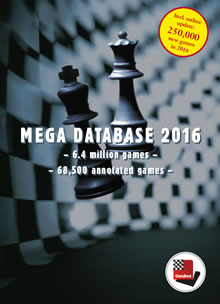
Leonardo Ljubicic
You are the 28th World Champion in Correspondence. Tell us something about your background.
I am 49 years old, married, and father of three children, two sons (23, 17), and one daughter who is 20. I live in Omiš, a small, beautiful town at the Adriatic Coast, about 25 km south of Split.
I think I learned to play chess when I was about nine years old. In 1977 I played my first club games and my name appeared for the first time in the archives of our local chess club. Around that time I also started to play correspondence chess.
My father Ante was a high school teacher of mathematics and a chess enthusiast. He was also the alpha and omega behind our local chess club and a keen correspondence chess player. I got addicted pretty fast to both disciplines: over-the-board play and correspondence chess. If I recall correctly, my father thought that to play correspondence chess at such a young age would help my chess and my character. It would teach me to organize myself (order and a systematic approach is needed to keep track of all the games and the many postcards that kept coming in bringing new moves) and to be more patient. It worked!
I also noticed very early that time pressure was my greatest enemy in over-the-board chess, and here correspondence chess came in very handy. Correspondence chess also helped me to explore the laws and theory of chess deeper.
You are not a chess professional. Is your work and profession related to chess?
Indeed, for me chess is “just” a hobby. I studied to become a Mechanical Engineer, B.Sc.., but during the course of my career I have worked in all sorts of managerial jobs, and thus I think I might best be seen as an expert in business administration and marketing. But no, nothing connected to chess.

The final of the Correspondence Chess Championship was a 17-player round-robin tournament, in which you scored 10.0/16 to become clear first. Modern correspondence chess is very different from the time when you made the first steps in correspondence chess. What has changed and how are todays’ World Championships organised?

Outdated: a postcard for correspondence chess
Correspondence chess has indeed evolved over the years. We don’t use postcards anymore but play on the webserver of the ICCF, the International Correspondence Chess Federations. The players come from all parts of the world and are members of their national federations – very similar to the organisation of OTB chess.
What FIDE is to OTB chess, the ICCF is to correspondence chess and they adhere to a strict set of rules that govern play in general and play in tournaments. With all due respect to many chess servers, the ICCF is by far the world’s most serious place for online chess. We have a wide range of tournaments, world and zonal championships, team Olympiads, friendly matches, invitation, class and promotional tournaments, world cups, and so on. There is also a small but ever growing group of players who play Chess960. The ICCF maintains its own rating list, officials and national delegates meet every year to discuss and, if necessary, revise rules and guidelines, and to talk about the development of the server and correspondence chess in general.
All in all, I would say the ICCF made a well-balanced and timely transformation from the age of postal chess to a contemporary, modern and respectable organization that keeps the spirit of correspondence chess alive.
The World Championships are played in cycles. Every year a new cycle starts and finals are played every two years. The standard time control is 50 days for 10 moves and competitive tournaments are finished within a period of two years – though not every game lasts that long.
You have to pass three preliminaries (Preliminaries, Semifinals, Candidates) successfully before you can play in WCCC Final. However, if your rating is high enough or if you hold a prestigious title you might enter the cycle in the Semifinals. So, on average, you need four to six years to qualify for a world championship final.
However, that is not easy task: not surprisingly, world championships are the strongest series of tournaments within the ICCF. The Preliminaries are typically category III tournaments (2300+), Semifinals are already category VIII (2425+) tournaments, and if you somehow manage to win both levels you qualify for the Candidates – which is essentially a horrible place to be J. Here the absolute best, the most promising and the most agile compete. The Candidates usually are category XI-XII (2525) tournaments and only the winners and sometimes the players finishing second qualify for the final.

Hard work but fun
How did you qualify for the final?
Up to 2007 I was merely a casual CC player, indulging myself in human-computer interaction, lingering around 2450 level. But I had once played a Candidates tournament and despite my decent result I was overwhelmed by the sheer strength of the 2600+ players I had to play against.
However, I had qualified for two more Candidates and I remember that one day in 2008 I had a long and hard thinking session wondering whether I should really give it a shot or not? I finally decided to go for it but I knew that it would never work unless I gave it everything – my free time and the “machinery”. At that time my kids were already half-grown and after my wife reluctantly gave me green light to go ahead I equipped myself with an early version of a 4-core PC, acquired all sorts of opening books, databases, and the Nalimov five piece tablebases – I thought it was necessary to cover all phases of the game with the best the chess world had to offer.
I then entered the two Candidates tournaments I had qualified for simultaneously, hoping for a success in one of them. I prepared and played seriously in both and the result was overwhelming: I won both tournaments and became a grandmaster doing so. However, I was too late for the final of the 27th WCCC 27 Final and had to wait till early 2013 to receive and accept an invitation for the 28th final. All in all it took me about five to six years of serious work and play to reach that stage.
But the finals were really time-consuming: I invested about twice the time I would usually invest in a standard category XIV tournament.
Today chess engines are much stronger than the best humans and many people wonder about the role of humans in correspondence chess. What can you do that the engines cannot do?
It is indeed impossible to achieve any significant result in today’s correspondence chess without engines and databases. But we humans play, not the engines, and the input of humans mainly affects two areas: a) the choice of a suitable opening, and b) steering the engine toward (or away) from certain types of position.
If you want to be successful in top correspondence chess you can only play a certain set of openings because you simply cannot afford one single sub-optimal move – if you do, you will sooner or later regret it. That’s as certain as death and taxes.
How well you guide your engines depends on your general chess knowledge. The better your chess knowledge (the significance of pawn structures, good bishop, bad bishop, etc.) the better you will do here – today’s engines are very strong but they still misjudge positions. If you have enough time and patience and composure you can feed the computer with more good ideas than your opponent – exactly the process described by former World CC Champion GM Ron Langeveld in an interview on the ICCF website.
I used Rybka for a number of years but around 2012 and 2103 I switched to Stockfish. Of course, I tested other engines as well but these two are my main engines. I firmly believe that the top CC players must not change their engines too much because you have to understand and recognize the strengths and weaknesses of your engines. Otherwise, you again and again have to choose between two or three moves the engines suggest, however, without understanding the differences these moves.
In my case, this would basically mean that I, as a player with a FIDE rating of about 2200, had to evaluate the moves of several 3300+ “players”. That cannot up well. If you stick to one engine you gradually get to know it better, you know where it is strong, you know where it is weak, you know, which positions it plays well and which positions it does not like.
But you should not let the engine do all the work, for instance, by giving the engine a certain position, then leave the computer for a couple of hours, and when returning just check what the computer proposes. You will do much better if you watch the thinking process, to try to recognise and understand the strengths and weaknesses of the machine and to guide the analysis.
You also need a lot of patience! If you are unsure what move to make, wait – and sleep one night over it. Use your 24 hour time buffer. Let the engine finish the iteration. All top engines today prune very heavily, so using the “Next Best” function is the main tool for correspondence play.
I use the ChessBase GUI which is non-negotiable because of its stability and because it is easy use. I also use several databases, particularly the ICCF archive database. I also use the ChessBase MegaDatabase and the Playchess games database but ONLY for getting new ideas – human games are just too unreliable.

The Megadatabase - not all moves in there are correct but it
contains an enormous amount of ideas and inspiration.
I form opening trees in these databases but I do not rely on statistics. I analyse all variations carefully and only decide on my move after I’ve checked and prepared for all worst case scenarios. In CC you cannot rely on a “if he doesn’t see” strategy.
As much as my time allows I try to follow the latest in chess engine development. From what I’ve seen, the best engines of today are Komodo and Stockfish. Both have their virtues and ... well, almost no weaknesses. Stockfish calculates variations fast, and excels in tactics and attacking, while Komodo is solid in style, and its positional play is second to none. They are very close in strength continuously developed further. Both are an excellent choice for serious correspondence chess.
I have seen the latest ChessBase features such as Cloud, LiveBook and Let’s Check, and I find them exciting. They might be somewhat too “light” for elite correspondence chess players, but coupled with the amazing “Sampled Search” in Rajlich’s Fritz 15 they offer very exciting insights and help any chess player to enter the world of computer aided chess - highly recommendable for any OTB or casual CC player! In fact, I consider “Sampled Search” the biggest invention in computer chess ever.

Fritz 15...
To give you an idea how my approach to correspondence chess works in practice here is a crucial game from the final of the World Championship:
(Part 2 will follow soon)





























